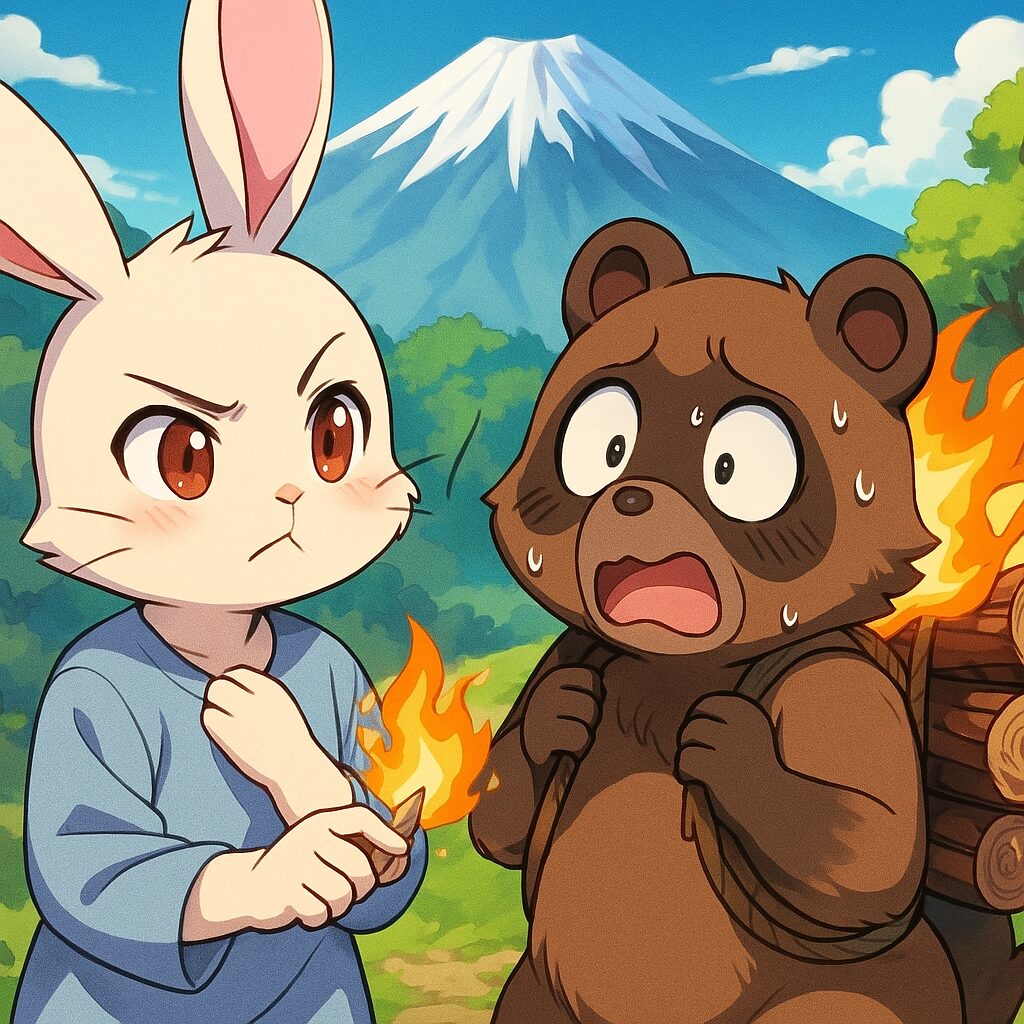Understanding Japanese emotions and values through traditional storytelling
- Introduction: Folktales as a Mirror of the Japanese Heart
- Story Summary: The Rabbit’s Revenge
- What Does “Kachikachi” Mean?
- Why Did the Rabbit Seek Revenge? Japanese Ethics and Emotion
- Symbolism of the Rabbit and Tanuki
- Modern Perspective: Is Revenge Justice?
- Is There a Real “Kachikachi-yama”?
- Comparison with Other Folktales: Momotaro
- Conclusion: Kachikachi-yama as an Emotional Tale
- Related Links
- はじめに:昔話に込められた日本人の心
- 物語のあらすじ:ウサギの復讐
- カチカチ山の「カチカチ」とは?
- なぜウサギは復讐したのか?—日本人の感情と倫理観
- ウサギとタヌキの象徴性
- 現代的な視点:復讐は正義か?
- 実際のカチカチ山の舞台はどこ?
- 他の昔話との比較:桃太郎との違い
- まとめ:カチカチ山は「感情の物語」
- 関連リンク
Introduction: Folktales as a Mirror of the Japanese Heart
Japanese folktales are more than just stories for children. They reflect the values, emotions, and historical realities of the people who told them. “Kachikachi-yama,” often described as a revenge tale between a rabbit and a tanuki (raccoon dog), reveals layers of morality, grief, and justice deeply rooted in Japanese culture.
Story Summary: The Rabbit’s Revenge
Long ago, an elderly couple lived peacefully in a mountain village. One day, the old man caught a tanuki that had been destroying their crops. He tied it up and brought it home. While the old woman was preparing to cook, the tanuki escaped and tragically killed her.
The rabbit, a close friend of the old woman, vowed revenge. He tricked the tanuki into carrying firewood up a mountain, then used flint stones to ignite the bundle. When the tanuki asked, “What’s that sound?” the rabbit replied, “It’s the sound of Kachikachi-yama.” The fire eventually burned the tanuki’s back.
Later, the rabbit applied hot pepper instead of medicine to the tanuki’s wounds and finally tricked him into riding a mud boat, which sank in the lake. Thus, the rabbit completed his revenge.
What Does “Kachikachi” Mean?
“Kachikachi” is the sound of flint stones striking together. In old Japan, people used flint to start fires. The rabbit’s use of flint symbolizes the beginning of his revenge and gives the tale its title.
Why Did the Rabbit Seek Revenge? Japanese Ethics and Emotion
While the rabbit’s actions may seem cruel, the story is built on the concept of inga ōhō (cause and effect). In Japanese morality, wrongdoings must be repaid. The rabbit’s revenge is not blind rage—it’s a response rooted in loyalty and justice. He honors the memory of the old woman and acts on behalf of emotional and moral duty.
Symbolism of the Rabbit and Tanuki
- 🐰 Rabbit: Often seen as clever and kind, sometimes even sacred in Japanese mythology (e.g., the moon rabbit).
- 🦝 Tanuki: A shapeshifting trickster in folklore, known for deceiving humans and causing mischief.
Modern Perspective: Is Revenge Justice?
From a modern viewpoint, the rabbit’s actions might be considered excessive. However, folktales reflect the values of their time. In eras without formal justice systems, stories like this served to illustrate moral lessons and emotional truths.
Is There a Real “Kachikachi-yama”?
Yes! In Yamanashi Prefecture, near Lake Kawaguchi, there’s a tourist spot named after the tale. Visitors can ride the Mt. Fuji Panoramic Ropeway and enjoy views of Mt. Fuji, as well as themed attractions like the “Rabbit Shrine” and “Tanuki Tea House.”
▶️ Mt. Fuji Panoramic Ropeway Official Site
Comparison with Other Folktales: Momotaro
Unlike “Kachikachi-yama,” which is driven by emotion and revenge, “Momotaro” is a tale of heroic justice. Both stories teach moral lessons, but from different emotional angles.
Conclusion: Kachikachi-yama as an Emotional Tale
- The rabbit’s revenge reflects loyalty and justice
- The tanuki’s fate teaches the principle of cause and effect
- Folktales mirror the emotional and moral landscape of their time
- Universal themes make the story accessible to global readers
Related Links
🔥カチカチ山:ウサギとタヌキの因縁に秘められた日本文化の深層
日本の昔話を通じて、日本人の感情と価値観を読み解く
はじめに:昔話に込められた日本人の心
日本の昔話は、単なる子ども向けの物語ではありません。そこには、自然との共生、善悪の価値観、そして人間の感情の複雑さが織り込まれています。今回ご紹介する「カチカチ山」は、ウサギとタヌキの復讐劇として知られていますが、その裏には日本人の倫理観や感情の機微が潜んでいます。
物語のあらすじ:ウサギの復讐
昔々、ある山里に心優しい老夫婦が住んでいました。ある日、畑を荒らすタヌキを捕まえたおじいさんは、タヌキを縄で縛り、家に持ち帰ります。おばあさんが料理の準備をしている間、タヌキは油断した隙をついて逃げ出し、なんとおばあさんを殺してしまいます。
この残酷な事件を知ったウサギは、親友だったおばあさんのためにタヌキへの復讐を誓います。ウサギは巧妙な罠を仕掛け、タヌキに薪を背負わせて山を登らせ、火打石で「カチカチ」と音を立てて火をつけます。やがて薪に火がつき、タヌキは火傷を負います。その後もウサギは、火傷に塗る薬と偽って唐辛子を塗ったり、泥船に乗せて湖に沈めたりと、次々に復讐を果たしていきます。
カチカチ山の「カチカチ」とは?
「カチカチ」とは、火打石を打ち鳴らす音です。昔の日本では、火を起こすために火打石を使っていました。ウサギが火打石を使って薪に火をつける場面は、当時の生活習慣を反映しています。
なぜウサギは復讐したのか?—日本人の感情と倫理観
ウサギの行動は一見すると残酷ですが、日本の昔話では「因果応報(いんがおうほう)」という考え方が根底にあります。悪いことをすれば、必ず報いを受けるという教えです。また、日本人の感情には「恩義(おんぎ)」や「情(じょう)」が深く根付いています。ウサギはおばあさんへの恩を忘れず、その死を悼み、正義を貫くために行動したのです。
ウサギとタヌキの象徴性
- 🐰 ウサギ:知恵と優しさの象徴。月に住む神聖な存在として描かれることも。
- 🦝 タヌキ:変化の術を使う妖怪的存在。人を騙すキャラクターとして登場することが多い。
現代的な視点:復讐は正義か?
現代の価値観では、ウサギの復讐は「過剰な報復」とも捉えられます。しかし、昔話は時代背景を反映したもの。当時の社会では、法による裁きが十分でなかったため、物語の中で「正義」が描かれることが重要でした。
実際のカチカチ山の舞台はどこ?
静岡県の伊豆地方には「カチカチ山」と呼ばれる観光地があります。富士山を望む絶景スポットとしても知られ、物語の舞台とされることがあります。
他の昔話との比較:桃太郎との違い
同じく人気の昔話「桃太郎」は、鬼退治という明確な正義の物語です。一方、カチカチ山は感情の復讐劇であり、より人間的な感情に寄り添った内容です。
▶️ 桃太郎の物語はこちら
まとめ:カチカチ山は「感情の物語」
- ウサギの復讐は、恩義と正義の表現
- タヌキの悪行は、因果応報の教訓
- 昔話は、時代背景と感情の鏡
- 海外読者にも伝わる普遍的なテーマ



コメント